NHS Scotland crisis: A&E waiting time performance falls to lowest level since 2022 as Humza Yousaf's recovery plan accused of 'no impact'
Humza Yousaf’s recovery plan to help the NHS has had “no impact on the crisis”, it has been claimed, as waiting time performance fell to its worst level since 2022.
Performance in Scottish emergency departments has declined in the latest weekly data, with just 59.4 per cent of patients waiting less than four hours for admission, transfer or discharge.
Advertisement
Hide AdAdvertisement
Hide AdThe most recent figures, for the week ending January 7, show the percentage falling below 60 per cent for the first time since 2022. During the week ending December 31, the figure stood at 60.6 per cent.


The lowest point in the data series was the week ending December 18, 2022, when it fell to 54.8 per cent.
The most recent week’s data also shows 18.1 per cent of patients spent more than eight hours in an emergency department and 9 per cent were there for more than 12 hours.
Scottish Liberal Democrat leader Alex Cole-Hamilton said the NHS recovery plan needed an urgent overhaul.
He said: “A year after some of the worst A&E waiting times in history, we find ourselves right back there again. Humza Yousaf’s NHS recovery plan appears to have had no impact on the crisis in our NHS.
“Michael Matheson has been too distracted by salvaging his career to focus on the needs of staff and patients. Scotland needs a Government laser-focused on the day job.”
Health secretary Michael Matheson said: “I am clear that performance remains below the levels we all wish to see and we continue to work closely with boards to support the delivery of sustained improvements.
“The heightened winter pressure being felt by our A&Es, which is not unique to Scotland, with similar challenges being felt by emergency departments throughout the UK, is being impacted by high levels of flu and Covid as well as staff sickness.
Advertisement
Hide AdAdvertisement
Hide Ad“Our winter plan is supporting boards to maximise capacity to meet demand, including expanded Hospital at Home services that are helping more people receive care at home or as close to home as possible, where clinically appropriate. This aims to relieve pressure on the front door of our A&Es.”
Mr Matheson said the Government was also working to tackle delayed discharge in hospitals.
But Scottish Conservative shadow health secretary Dr Sandesh Gulhane said: “These woeful figures lay bare the intolerable crisis across Scotland’s A&E wards, but the situation at the flagship hospital in our largest city is catastrophic and beyond dangerous.
“It’s barely conceivable that less than one-third of patients at the Queen Elizabeth were seen within the SNP’s target of four hours. This is terrifying for patients.
“Dedicated frontline staff are not to blame for this. They are being made to carry the can for the appalling workforce planning of successive SNP health secretaries, which has left them hopelessly under-resourced. But, equally, the health board must be accountable for its failings, so it should be put into special measures.
“All the modelling shows us that excess delays in A&E lead to tragic and avoidable loss of life – but the distracted and discredited Michael Matheson has not just failed to get a grip on the crisis, he’s allowed it to get worse."
Comments
Want to join the conversation? Please or to comment on this article.